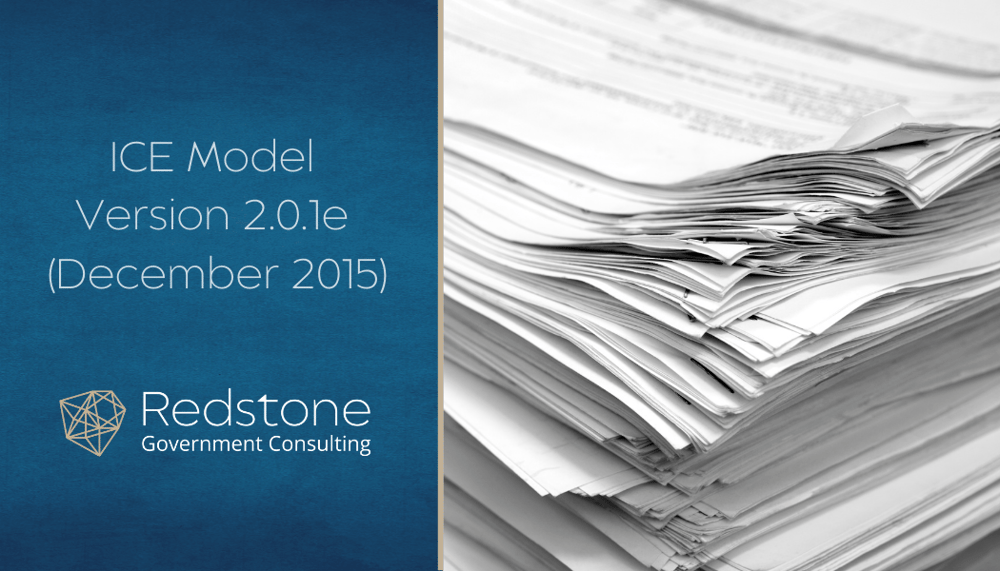
DCAA has recently released a new version of the ICE Model, which is the electronic version of the “Model Incurred Cost Proposal” that provides contractors with a standard ICE submission for preparing adequate incurred cost proposals in accordance with FAR 52.216-7, “Allowable Cost and Payment.” This version 2.0.1e released in December 2015, may be downloaded from DCAA website. There were no computational changes to the newly released version, however, additional information will be required for Schedule J. Schedule J provides DCAA with the Subcontract Information such as contact information, subcontract value, period of performance, costs incurred for each subcontractor, and award type. In the 2.0.1e version, additional information such as prime contract value and subcontractor’s duns number has been added to the required information for this schedule. This is the second version of the ICE Model released this year. ICE Version 2.0.1d released in August 2015, had no computational or functional changes to the previous Version 2.0.1c (June 2012).
Although relatively little has changed since 2012, contractors should be aware of the change to Supplemental Schedule C. A note has been added to Supplemental C to clarify what information is to be entered on this schedule. Supplemental Schedule C requires the identification of prime contracts under which the contractor performs as a subcontractor. The change includes identification of subcontract efforts awarded to your company at the pricing action level (e.g. delivery order, CLIN) for all subcontract efforts (e.g. cost-type, incentive contracts, T&M/LH, FFP etc.). This is different from Schedule J which requires identification of subcontracts you have awarded to companies for which you are the prime or upper-tier contractor, including inter-divisional effort. In addition, Schedule J requires all subcontract awards (e.g. cost-type, incentive contracts, T&M/LH, FFP etc.) issued under flexibly-priced prime contracts (which include IDIQ prime contracts which have multiple contract types). Whereas Supplemental Schedule C, is requiring contractors to include all contracts in which the company is a subcontractor no matter the prime contract type. Therefore, firm fixed price and commercial contracts that the company is a subcontractor would be included on this schedule. Typically these type contracts are excluded for audit purposes. The FAR 52.216-7, “Allowable Cost and Payment” states that supplemental information is not required to determine if a proposal is adequate, but may be required during the audit process. Since this is the expectation, a contractor would be wise to complete this schedule to have on file for the audit. However, the contractor should be aware that other than the information provided for this schedule, DCAA should not audit firm fixed price or commercial contracts.
In terms of translating DCAA’s latest expectations into risk, even if a subcontract is fixed-price, DCAA might be pursuing a cost disallowance at the prime if the prime contract is cost-type. If DCAA asserts that the prime contractor cannot demonstrate that the fixed price subcontract is a fair and reasonable price, DCAA may then challenge the reasonableness (FAR 31.201-3) of the fixed price subcontract as a “cost” flowing into a a cost-type prime contract.


 Kimberly is a Managing Consultant with Redstone Government Consulting, Inc. based in our Huntsville, Alabama office. Her areas of expertise include working with government contract accounting and contracting issues and audit. Kimberly specializes in assisting government contractors in the unique accounting, pricing, proposal preparation, and compliance requirements of the U.S. Government. Professional Experience Kimberly’s experience includes preparation of complex incurred cost submissions, compliant accounting infrastructure, preparation and evaluation of policies and procedures, contract closeout process, developing provisional indirect rate budgets, monitoring actual indirect rates, and providing audit support to government contractors. Her primary focus is working pro-actively in preparing small contractors for government contract challenges as well as resolving DCAA issues. Kimberly has almost ten years of experience assisting clients with Federal Acquisition Regulations (FAR) and Cost Accounting Standards (CAS) best practices and compliance. She works with government contractors to comply with critical Federal Acquisition Regulations (FAR) requirements related to cost accounting and proposals. Her sundry experience with various government contract issues and successful resolutions provides insight that benefits our clients. Prior to joining Redstone Government Consulting, Inc., Kimberly specialized in assurance and advisory services with a regional firm (Jackson Thornton), working as a staff accountant conducting compilations and reviews, auditing financial statements and assisting with litigations. Education Kimberly earned a Bachelor of Science degree in Commerce and Business Administration from The University of Alabama in 2007. Affiliations National Contract Management Association Women in Defense
Kimberly is a Managing Consultant with Redstone Government Consulting, Inc. based in our Huntsville, Alabama office. Her areas of expertise include working with government contract accounting and contracting issues and audit. Kimberly specializes in assisting government contractors in the unique accounting, pricing, proposal preparation, and compliance requirements of the U.S. Government. Professional Experience Kimberly’s experience includes preparation of complex incurred cost submissions, compliant accounting infrastructure, preparation and evaluation of policies and procedures, contract closeout process, developing provisional indirect rate budgets, monitoring actual indirect rates, and providing audit support to government contractors. Her primary focus is working pro-actively in preparing small contractors for government contract challenges as well as resolving DCAA issues. Kimberly has almost ten years of experience assisting clients with Federal Acquisition Regulations (FAR) and Cost Accounting Standards (CAS) best practices and compliance. She works with government contractors to comply with critical Federal Acquisition Regulations (FAR) requirements related to cost accounting and proposals. Her sundry experience with various government contract issues and successful resolutions provides insight that benefits our clients. Prior to joining Redstone Government Consulting, Inc., Kimberly specialized in assurance and advisory services with a regional firm (Jackson Thornton), working as a staff accountant conducting compilations and reviews, auditing financial statements and assisting with litigations. Education Kimberly earned a Bachelor of Science degree in Commerce and Business Administration from The University of Alabama in 2007. Affiliations National Contract Management Association Women in Defense